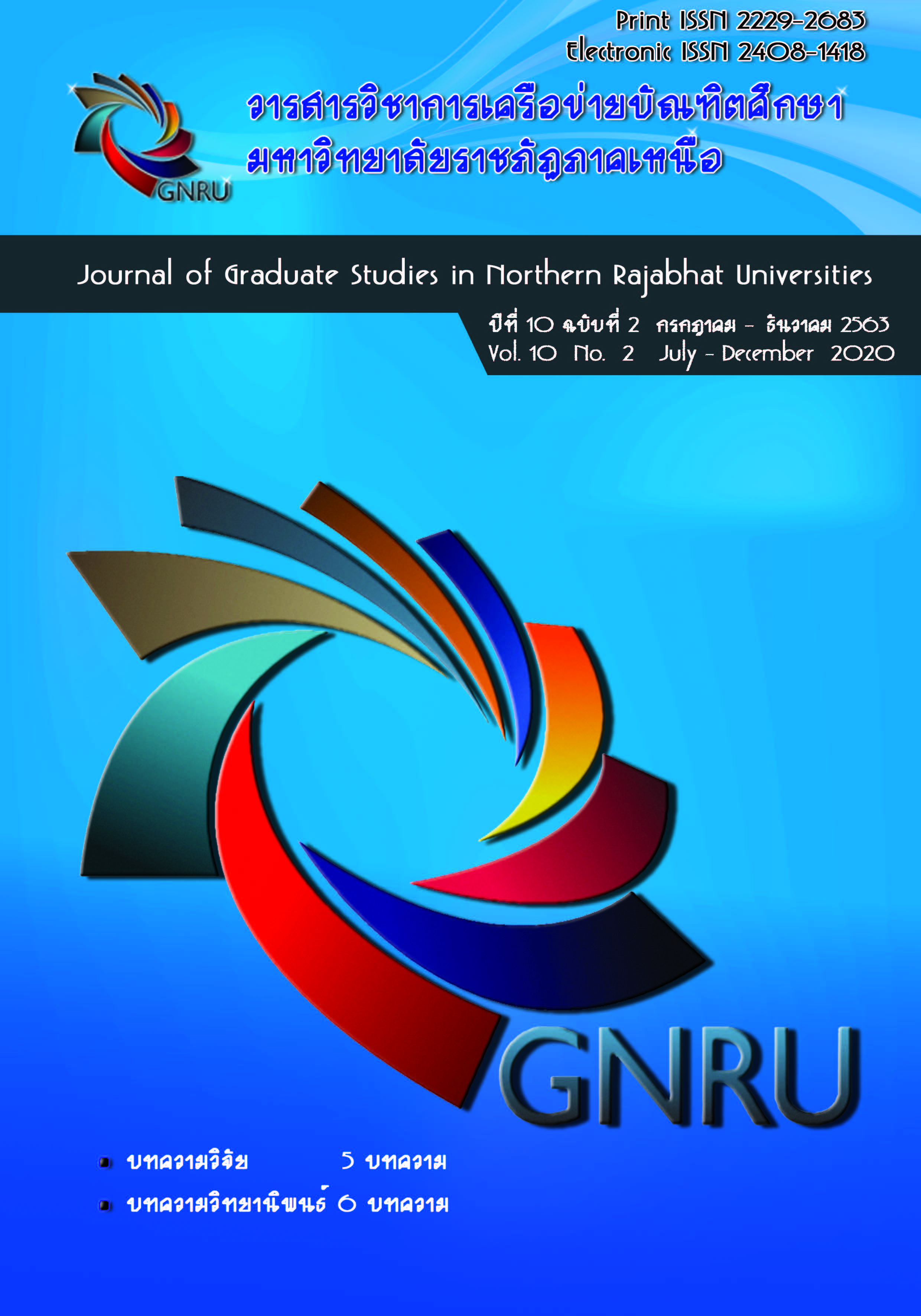การบริหารจัดการเชิงพุทธของมหาวิชชาลัยพุทธเศรษฐศาสตร์ The Buddhist Management of Mahavijjalaya of Buddhist Economics
Main Article Content
Abstract
งานวิจัยนี้มีวัตถุประสงค์เพื่อศึกษาการบริหารจัดการเชิงพุทธของมหาวิชชาลัยพุทธเศรษฐศาสตร์ ศึกษาการบริหารจัดการเชิงพุทธด้านการศึกษาของโรงเรียนชาวนาพุทธเศรษฐศาสตร์ และสร้างต้นแบบการบริหารจัดการเชิงพุทธด้านการศึกษาสำหรับสถานศึกษานอกระบบ
ผลการศึกษา พบว่า 1. การบริหารจัดการเชิงพุทธของมหาวิชชาลัยพุทธเศรษฐศาสตร์ มีโครงสร้างการบริหารออกเป็น 3 ส่วน คือ โรงเรียนชาวนาพุทธเศรษฐศาสตร์ โรงเรียนชีวกานุสรณ์ และโรงเรียนสืบศิลป์ถิ่นล้านนา การบริหารจัดการเชิงพุทธของมหาวิชชาลัยพุทธเศรษฐศาสตร์เป็นการบริหารจัดการที่ผสมผสานระหว่างการนำศาสตร์การจัดการสมัยใหม่ แล้วนำหลักธรรมทางพระพุทธศาสนามาประยุกต์ใช้ในการบริหารจัดการ ได้แก่ (1) อริยสัจจ์ 4 (2) สัมมับปธาน 4 (3) สุจริต 3 (4) สังคหพละ 4 (5) เวสารัชชกรณะ 5 (6) สัปปุริสธรรม 7 (7) ทศพิธราชธรรม 10 (8) พรหมวิหารธรรม 4 (9) กาลามสูตร (10) ทิฏฐธัมมิกัตถะ 4 และ (11) สังคหวัตถุ 4 2. การบริหารจัดการเชิงพุทธด้านการศึกษาของโรงเรียนชาวนาพุทธเศรษฐศาสตร์ มีรูปแบบการบริหารจัดการด้านการศึกษาที่มีลักษณะเฉพาะ คือ (1) แนวคิดหลักมุ่งเน้นการแก้ปัญหาความยากจนด้วยสัมมาชีพและเกษตรแบบอินทรีย์สู่การพัฒนาอย่างยั่งยืน ด้วยการลงมือทำ (2) อัตลักษณ์ของนักเรียนกำหนดออกเป็น 10 ข้อ โดยใช้ธรรมะเป็นแกน และ (3) หลักสูตรแกนกลางมุ่งเน้นเศรษฐศาสตร์มัชฌิมา การพัฒนาอย่างยั่งยืนด้วยการรวมศาสตร์ทางพุทธธรรม พุทธเกษตร พุทธวัฒนธรรม เศรษฐศาสตร์ และศาสตร์สมัยใหม่เข้าด้วยกัน และ (4) ตัวชี้วัดความสำเร็จของนักเรียนต้องผ่านเกณฑ์ 3 ข้อ คือ อยู่รอด อยู่ได้ และอยู่ดี 3. การสร้างต้นแบบการบริหารจัดการเชิงพุทธด้านการศึกษาสำหรับสถานศึกษานอกระบบ มีรูปแบบ 2 ประการใหญ่ ๆ ได้แก่ (1) ลักษณะผู้เรียนที่พึงประสงค์จะต้องประกอบด้วยอัตลักษณ์ 10 ประการ และ (2) ระบบการจัดการศึกษาเป็นระบบการศึกษาที่ลงมือปฏิบัติ
Buddhist Management of Mahavijjalaya of Buddhist Economics consists of objective is to research the Buddhist Management of Mahavijjalaya of Buddhist Economics and also research about the education of Agricultural Buddhist Economics School, as well as building a Buddhist management educational model for non-formal education. (Agricultural Buddhist Economics School).
The study indicated that: 1. The Buddhist Management of Mahavijjalaya of Buddhist Economics consists of administrative structure which is divided into 3 parts namely Agricultural Buddhist Economics School, Cheevaganusorn School and Lanna Art Conservative School. Buddhist management of Mahavijjalaya of Buddhist Economics is a combination of modern management science, together with the principles of Buddhism applied in the management, including (1) Four noble truths (2) Four right efforts (3) Three good conducts (4) Four Power of sympathy (5) Five intrepidities (6) Seven qualities of a good man (7) Ten virtues of the king (8) Four sublime states of mind (9) Ten Kalamasutta (10) Four virtues leading to temporal welfare and (11) Four bases of sympathy. 2. Educational management of Agricultural Buddhist Economics School includes unique educational management models that are: (1) focusing on solving the poverty problem with the honest occupations and organic agriculture towards sustainable development under the concept learning by doing (2) Dividing student's identities into 10 characters by using dhamma and (3) principle courses focus on moderate economics, sustainable development through the integration of Buddhism, Cultural Buddhist, Agriculture Buddhist, Economic, and Modern Sciences and (4) The student achievement indicators must meet three criteria: survive, self-sufficient and live well. 3. Form the model of Buddhist Educational Management for educational administration for non-formal education which consists of 2 major ideas; (1) 10 student's identities and (2) learning by doing is the man idea for educational management which includes 5 basis points.
Article Details
References
______. (2552). บริหารคนให้สำราญ บริหารงานให้สัมฤทธิ์. พิมพ์ครั้งที่ 2. กรุงเทพฯ: อมรินทร์ธรรมะ อมรินทร์พริ้นติ้งแอนด์พับลิชชิง.
______. (2559). เคล็ดลับหัวใจเศรษฐี. พิมพ์ครั้งที่ 3. กรุงเทพฯ: ปราน.
มานิต เตชวโร (อุดนอก), พระ. (2550). รัฐศาสตร์แนวพุทธ : พรหมวิหาร 4 กับนักปกครอง. วิทยานิพนธ์ ศาสนศาสตรมหาบัณฑิต (ศน.ม). มหาวิทยาลัยมหามกุฏราชวิทยาลัย, นครปฐม.
มูลนิธิวิมุตยาลัย. (2558). สรุปผลโรงเรียนชาวนา ครั้งที่ 1. เชียงราย: มูลนิธิวิมุตยาลัย.
อรรณพ โยนิจ. (2549). การใช้หลักพุทธธรรมในการบริหารงานของผู้บริหารโรงเรียนพระปริยัติธรรมแผนกสามัญศึกษา อําเภอเมืองเชียงใหม่. วิทยานิพนธ์ศึกษาศาสตรมหาบัณฑิต. มหาวิทยาลัยเชียงใหม่, เชียงใหม่.
Gardner, H. (1999). Intelligence Reframed: Mutiple Intelligenes for the 21th Gentury. New York: Basic Books.
Gulich H. Luther and Lyndall Urwick. (1973). The Science of Anministration. New York: Columbia University.
Koontz Haroll D. and Cyril O’Donnell. (1972). Principles of Management: An Analysis of Managerial Functions. New York: MC Craw-Hill.
Schweyer Allan. (2004). Talent Management System: Best Practices in Technology solutions for Recuitment, Retention and Workforce Plnning. Canada: Tri Graphic Print, John Wiley & Sons


